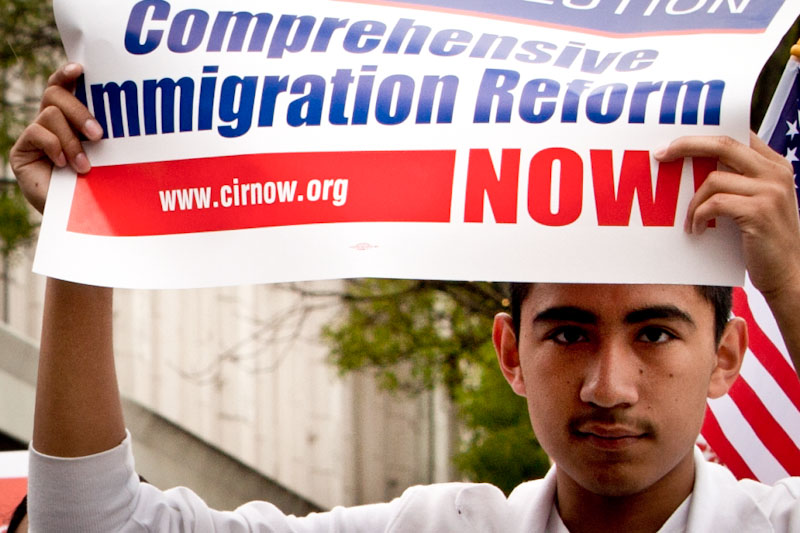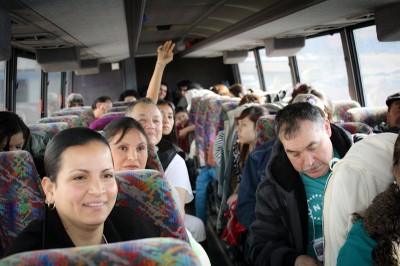 Washington’s diverse immigrant community isn’t afraid of going to the back of the line…as long as they’re sure of where it will lead.
Washington’s diverse immigrant community isn’t afraid of going to the back of the line…as long as they’re sure of where it will lead.
A busload of immigrants advocating for national reform rumbled across Washington last week. The Keeping Washington Families Together bus tour, one of several coordinated tours around the country, held rallies across the state and met with politicians they’re hoping to bring onto the immigration reform bandwagon.
On Saturday the tour, organized by Seattle-based immigration advocacy non-profit OneAmerica, wrapped up after a full ticket: Vancouver, Seattle, Wenatchee, Yakima, Tri-Cities and Walla Walla.
So what do they want?
The main rallying cry is ‘reform now.’
That was evidenced by signs and chants from the crowd throughout Wednesday’s rally at Seattle’s Casa Latina. Both political parties have trumpeted the prospects for reform a lot in recent months. But a sense that, without continued pressure, immigrants’ priorities could quietly fall by the wayside, still looms over immigrant communities.
“Once reform is on the table, once we can see that these issues are being taken up, then we can discuss specifics,” explained David Ayala-Zamora, organizing director for OneAmerica at the Seattle rally.

Immigrant communities expect a path to citizenship for all immigrants currently living the United States–and they expect that path to be clearly drawn.
The popular rhetoric that immigrants who have entered the US illegally will have to “get at the back of the line” is not being challenged. But immigrants want to see that that line will, in fact, lead directly to citizenship.
Also contentious is the guest worker program currently in place under federal law, which allows temporary visas to be allotted to foreign workers for seasonal jobs. Many immigrants know first-hand of the abuses attributed to guest worker programs at the hands of private labor contractors. If they can get legal status, undocumented workers will want the jobs guest laborers have been filling each year.
This demand plays into a broader fourth expectation: increased accountability and humanity in law enforcement. Rich Stolz, executive director for OneAmerica, spoke at the Seattle rally calling local enforcement of federal immigration law “a family separation machine” and advocating for reparations and improved oversight to help bridge the void of distrust between law officers and immigrant communities.
So what are they likely to acutally get?
Immigrants and their allies are likely to get reform soon. Bipartisan support fomented the comprehensive immigration reform proposal that has taken shape in the House of Representatives over the past two months, and Congress will likely take up a specific reform bill in April or May.

Over the qualms of a few, a Congressional majority is tentatively in favor of a path to citizenship for all immigrants currently in the United States–eventually.
Here’s where a lack of specific demands could come back to haunt reformers: there’s no telling how long the process might take. Eight years to full citizenship has been thrown out as an estimate. But conservative leaders like Rep. Marco Rubio of Florida stipulate that improved employee verification procedures, expansive exit system updates and tighter border control will have to be fully established before the first green card is awarded under the new system.
Meanwhile, guest worker programs are under review for reform…but not for elimination. In fact, they may expand.
The demand for cheap labor–especially in seasonal industries neglected by most American workers–has shown no signs of slowing. Even if the national workforce grows thanks to reform, the change will not be immediate, and while immigrants “wait in line” for legal worker status over the next several years jobs will likely need to be filled, at least for the time being, by guest workers.
So while the need for increased accountability, especially in private labor-recruitment companies, is widely recognized, the fact remains that there will be continued demand from businesses for labor they can afford. The reality of our free-market economy is that labor recruiters who meet that demand will operate until sufficient American workers can be recruited to fill the available positions.
As for humanity, it remains to be seen: between the nuts and bolts of funding allocation and tit-for-tat partisan bargaining it’s easy to forget that the millions who will be affected by reform are individuals with human needs. And that’s one place where the Keeping Washington Families Together bus tour has made a real statement.

The tour isn’t harping on specifics of immigration reform, but instead pushing values they want to be taken into consideration as bipartisan negotiations in D.C. proceed. The focus on family made the tour relatable for community members and for politicians.
“Too frequently, I hear from my constituents that current immigration policies are ripping families apart,” agreed Rep. Adam Smith, of Washingon’s 9th district, in an e-mail. “The bus tour offers a very compelling message with real, personal experiences…[it] helps show the need for immigration reform to make families a priority.”
Washington agriculture, business and faith leaders have taken notice too, and a focus on family is at the heart of the pro-reform Washington Compact signed by approximately 70 groups and individuals state-wide in the past two months. The Compact also argues that law enforcement officers should be allowed to focus on crime rather than “civil violations of federal law.” Similar compacts have been signed in five more states.
So while it’s hard to quantify the impact of campaigns like Keeping Washington Families Together, it is evident that the values they represent are increasingly in concert with those of policymakers in Washington and nationwide.
And that may be the real key to unlocking immigration reform.


Many of the values that unite Americans as a nation are tied to immigration–as Americans, our vision and values are framed as immigrant. U.S. immigration policy need change or “reform.” At the same time, it is important that “reform” enriches and broadens our communities, our history, and our underlying beliefs. No one ethnic group should dominate—that’s not diversity and that’s not the reform that would benefit the nation as a whole. According to a Pew Hispanic Center report, Mexicans make up 57 percent of the undocumented immigrants present in the United States. Another 24 percent are from other Latin American countries. Approximately 9 percent are from Asia, 6 percent from Europe and Canada, with the remaining 4 percent from the rest of the world.
There is certainly a great deal to learn about this subject.
I really like all of the points you made.